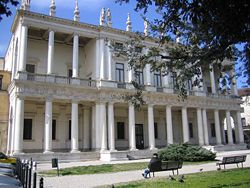Andrea Palladio
Andrea Palladio (November 30, 1508 – August 19, 1580), was an Italian architect, widely considered the most influential person in the history of Western architecture.
Biography
He was born Andrea di Pietro della Gondola in Padua, then part of the Republic of Venice. Apprenticed as a stonecutter in Padua when he was 13, he broke his contract after only 18 months and fled to the nearby town of Vicenza. Here he became an assistant in the leading workshop of stonecutters and masons. He frequented the workshop of Bartolomeo Cavazza, from whom he learned some of his skills.
His talents were recognised in his early thirties by Count Gian Giorgio Trissino, who later gave him the name Palladio, an allusion to the Greek goddess of wisdom Pallas Athene. In 1541 he moved to Rome to study classic architecture.
Palladian style, named after him, adhered to classical Roman principles, similarly to styles of the Early and High Renaissance, when classical revivalism was at its peak. His architectural works have "been valued for centuries as the quintessence of High Renaissance calm and harmony" (Watkin, D., A History of Western Architecture). Palladio designed many churches, villas, and palaces, especially in Venice, Vicenza and the surrounding area. A number of his works are protected as part of the World Heritage Site Palladian Villas of the Veneto.
His style became fashionable all over Europe, for example in parts of the Loire Valley of France. In Britain, Inigo Jones and Christopher Wren embraced the Palladian style. Another admirer was the architect Richard Boyle, 4th Earl of Cork, also known as Lord Burlington, who, with William Kent, designed Chiswick House. The Palladian villa configuration, consisting of a dominant central focal element flanked by lower servant wings, found resonance as a prototype for the country mansions of the English nobility, a perfect architectural expression of their position in the social order of the era. Other exponents of his work who helped to popularize Palladio's concepts include the 18th century Venetian architect Giacomo Leoni who published an authoritative four volume work on Palladio and his architectural concepts. In a letter written by Colonel Isaac A. Coles to General Hartwell Cocke in 1816, Coles related Thomas Jefferson's admiration for Palladio: "With Mr. Jefferson I conversed at length on the subject of architecture—Palladio, he said, 'was the Bible—you should get it and stick close to it...'"
He died in Maser, near Treviso.
Credits
New World Encyclopedia writers and editors rewrote and completed the Wikipedia article in accordance with New World Encyclopedia standards. This article abides by terms of the Creative Commons CC-by-sa 3.0 License (CC-by-sa), which may be used and disseminated with proper attribution. Credit is due under the terms of this license that can reference both the New World Encyclopedia contributors and the selfless volunteer contributors of the Wikimedia Foundation. To cite this article click here for a list of acceptable citing formats.The history of earlier contributions by wikipedians is accessible to researchers here:
The history of this article since it was imported to New World Encyclopedia:
Note: Some restrictions may apply to use of individual images which are separately licensed.
